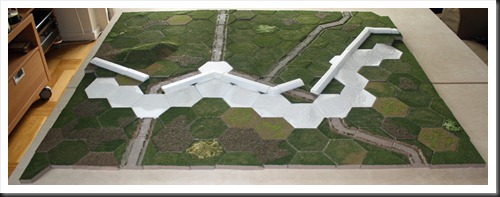Over last couple of months, I've been toying with the idea of writing a couple of posts about GHQ Terrain system. I am not a master terrain maker nor do I claim to be an expert in GHQ Terrain "field", but I've been using it for a couple of years and I do believe that I have gained a bit of insight about advantages and disadvantages of this system, as seen from the point of view of average wargamer. Also, just like with most of things, there seems to be a right way and a wrong way to do stuff with GHQ Terrain. I think that by now I have made most of the common mistakes and figured out few things that could be of benefit for others, so why not share it with people for whom this information could be useful?
My plans about more in depth posts are for the moment hindered by real life obligations, but since I am in process of setting up terrain for an ACW scenario, it occurred to me that I could use that process as a background for an introduction to the topic. So... below is the picture of preliminary terrain setup I intend to use for Grant's assault on Fort Donelson. There is still some work left to do, but for a "first fitting" things don't look too shabby.
Here is a couple of facts in connection with this setup, just to give you a general idea about GHQ Terrain system. It is about 140 cm by 95 cm (sorry guys, metric system is the way to go) and consists of about 250 hexes. mostly of 1/2 inch variety. In case you wonder why so many hexes are needed, the reason is the elevation that runs throughout the board and covers about 2/3 of it. After giving it a bit of a thougt about how to depict that terrain feature, I decided to try two 1/2 inch hexes on top of each other and it seems to work pretty fine. Reason why I’m mentioning it is that there is a couple of approaches to deal with elevations when using GHQ Terrain tiles – each of them has its own set of drawbacks and advantages.
Another thing that can be of interest is the fact that this board is built of five different basic tile types and four of those tile types have several variations. Basic plane hex is one of those tile types, obviously. Road hexes are of two different types - one with road running between straight vertices and one with roads running between diagonal vertices of the hex. Then there are elevation hexes - if I'm not mistaken, there are five possible shapes of those, although in this setup only three are used.
By now two things should be apparent - it is a work intensive system and it demands a bit of effort and dedication before a certain level of versatility is achieved. Furthermore, a bit of an financial inverstment is required even for basic setup. Those things need to be considered carefully before choosing GHQ as the terrain solution for wargames.
